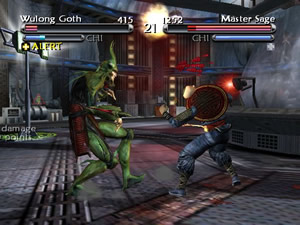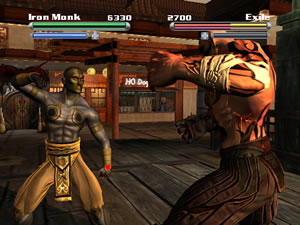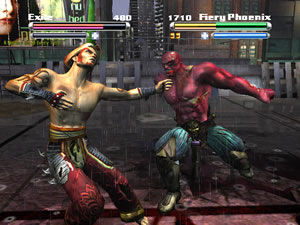Flower power.
Perhaps no genre has undergone as few major changes over the years as the fighting
game. Ever since Street Fighter II blew open the doors to the left/right
battle concept, we’ve seen only minor if notable tweaks. Virtua
Fighter and Battle Arena Toshinden brought
us into the third dimension, Tekken
brought scads of linkable moves and current kingpin Soul
Calibur raised the bar in terms of gameplay depth and graphics, but by and
large the fighters follow the same formula and borrow move sets like lawnmowers.
Even Bushido Blade, which promised all sorts
of cool changes, only wound up falling into obscurity.
So
when a new series hits the market, we at GR get excited. Could this be the one
to add some genuinely new flavor to what has become a rather redundant broth?
Will this one up the ante once again by fleshing out the usually throwaway single-player
experience? Might this one be the diamond in the rough?
So long as this one isn’t Tao Feng: Fist of the Lotus, the answer is
still "maybe."
Coming from Mortal Kombat guru John Tobias, Tao Feng has large,
bloody footprints to fill. Unfortunately, some good ideas are handled badly
and some basic, necessary rules are strangely ignored, leading to a thoroughly
sub-par combatant.
The backstory makes Street Fighter look like Hamlet.
Two warring clans – the Pale Lotus and the Black Lotus – are duking it out over
some mystical artifacts which, when found, will unlock the doors to somewhere
magical in order to make people immortal, maybe, or at least very hard to kill,
or thereabouts. It’s all pretty unclear. Good luck to you.
Matching the far-fetched plot is an odd group of characters. Some are interesting,
such as the Iron Monk or token big guy Exile, while others are simply cookie-cutter
material, such Fiery Phoenix or token old man Master Sage. Then there’s Divine
Fist, who is the spitting image of Jet Li, and the various women, all of whom
have big chests that flop around like water balloons in their pre-fight katas.
Like every fighting game since Greco-Roman wrestling, you pick a guy and try
to beat up the other guy. The simplest way to do this is Arcade mode, but Tao
Feng doesn’t have one in the classic sense. Rather, they’ve renamed it Versus
mode, a title usually reserved for multiplayer games. You can set up a one-on-one
fight here against the computer or a human, though it’s just a single match
sans any kind of plot. When you win or lose, you simply get a ‘Game Over’ screen
and the choice to fight again or set up a new one. It’s a bit confusing, I know.
The real main single-player mode is Quest, which puts you up against
the 6 characters from the other side in a three-fall brawl. However, you get
to choose which order to fight them in, which is nice if you like doing more
work than you should have to do in a fighting game. I suppose it’s handy in
terms of strategy – regardless of the order, things gradually get harder, so
if you’re scared of one opponent in particular, you can choose to fight them
early on when they’re easier.
At any rate, Quest mode falls far short of delivering a decent single-player
experience. There is no FMV to flesh out the plot and there’s a total lack of
any sort of ending FMV after you beat all 6 characters in the other clan. Rather,
you just get spit back out to the Character Select screen with the character
you just played as blacked out. Very shoddy work.
If you manage to beat the other clan with all 6 characters on your side, you
get to fight the game’s only boss. Beat him and you’ll get one of two unsatisfying
ending FMVs (one per clan). Even Street Fighter II gave you specific
ending sequences for the different fighters.
Once you tire of the Quest debacle, you can try out a few other ubiquitous modes. There’s standard Survival mode as well as a Team Battle. Multiplayer modes include Versus and a Tournament. There are also two types of Training, both of which do an adequate job of showing you the ropes.
But regardless of the mode, the gameplay is not up to snuff. In addition to
basic moves, each character has a few specific combos. The combos are essential
to doing any real damage, but there is no ‘combo breaking’ move to stop one
in progress. The computer never screws theirs up, so if the first punch hits
you, you could be in for a quick, unavoidable wallop.
 Tao
Tao
Feng is in full 3D, which means you can sidestep like a madman. But it also
means that the camera has to keep up, and in this case it’s asking too much.
Presumably to avoid having objects obscure the field of vision, the camera sometimes
swings around randomly and winds up with an opposite view of the action. While
you were just holding ‘back’ to guard a combo, you’re now pressing ‘towards’
and wind up getting nailed. It’s aggravating and stupid.
You also have a Chi meter, which increases as you do damage. When it’s full
you can pull of one of three Chi moves per character, which cannot be blocked
(though they can miss or be interrupted). You can also use your Chi meter to
heal limb damage, which is one of the game’s innovative design concepts.
By blocking attacks, you’ll gradually be warned against possible damage to
either your arms or legs. If you take a fall when the warning is red, your arm
or leg attacks are less effective. It’s a good idea, but it would have been
much more interesting if it was broken down into four sections (one for each
limb) rather than just arms or legs in general.
Tao Feng tries to add more innovation in its environments. The levels
are pretty big, and if you hit a guy into a wall or other debris, he’ll take
extra damage. You can also bounce off walls to get out of a jam or swing on
poles for some big attacks. Again, good ideas, but only marginally useful.
At least it looks okay, thanks to a smooth engine. The character models look
good (despite the gratuitous boobage) and the motion capture is at times impressive.
Fighters show wear and damage as the fight progresses. But once things get going,
you’ll notice plenty of overly jerky movement, which makes it look like the
older MK games from which it is clearly derived. The Chi moves tend to
add some flash, but also lead to framerate chugs.
Tao Feng winds up being a study in game design do’s and don’ts. DO
take innovative chances (limb damage, interactive environments), but DON’T sacrifice
FMV. DO give characters combos, but DON’T make them unbreakable. DO add plenty
of extras, but DON’T, um, well, DON’T forget that one.
And while you’re at it, DON’T bother dropping any cash on Tao Feng.
This lotus should only grow in the bargain bin.

-
Interactive environments
-
Limb damage
-
Decent graphics
-
Almost no FMV/Ending stories
-
No extras
-
Sub-par fighting system
-
Sketchy camera











